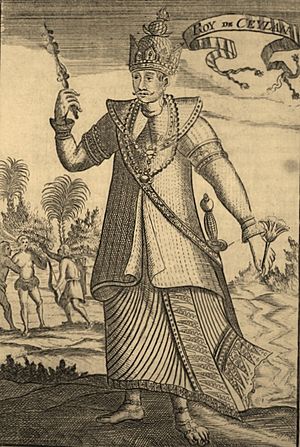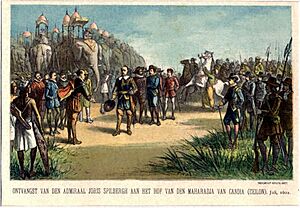Vimaladharmasuriya I of Kandy facts for kids
Quick facts for kids Vimaladharmasūriya I |
|
|---|---|
 |
|
| King of Kandy | |
| Reign | 1592–1604 |
| Predecessor | Rajasinha I of Sitawaka |
| Successor | Senarat of Kandy |
| Born | Konappu Bandara Peradeniya, Sri Lanka |
| Died | 1604 Royal Palace, Kandy, Sri Lanka. |
| Burial | Royal Cremation Yard, Asgiri Temple , Kandy, Sri Lanka. |
| Consort | Queen Kusumasana Devi of Kandy |
| Spouse | Dona Amelia (Yakadadoli) |
| Issue |
|
| Sinhala | පළමුවන විමලධර්මසූරිය |
| House | House of Dinajara |
| Father | Virasundara Bandara |
| Mother | Kosbokke Gedara Vimalu (concubine of Virasundara Bandara) |
| Religion | Theravada Buddhism previous Roman Catholicism |
Vimaladharmasūriya I was an important king of Kandy. He ruled from 1592 to 1604. He became famous for successfully defending his kingdom. He stopped two big attacks by the Portuguese on Kandy. These were the Battle of Danture in 1594 and the Battle of Balana in 1602. In both battles, the Portuguese faced big defeats.
Contents
Early Life and Rise to Power
His Names and Family
Vimaladharmasuriya I was known by a few names. His early name was Konappu Bandara. He was the son of a Kandyan leader named Weerasundara Bandara. His mother's name was Kosbokke Gedara Vimalu. He later took his name Vimaladharmasuriya from her.
Growing Up and Leaving Kandy
Konappu Bandara was born in Peradeniya, Sri Lanka. His father, Weerasundara Bandara, was a respected noble. Sadly, his father was killed by Rajasinghe I. Because of this, Konappu Bandara had to leave Kandy. He went to Portuguese Goa, where he became a Catholic. He learned fighting skills from the Portuguese there.
Return to Kandy
After some time, Konappu Bandara secretly returned to Kandy. The ruler appointed by Rajasinghe I was not popular. The people of Kandy were unhappy. This created a chance for Konappu Bandara to become king.
Vimaladharmasuriya's Reign
Becoming King of Kandy

Many historians see King Vimaladharmasuriya as the second founder of the Kandyan Kingdom. He helped it become strong again. He had been baptized by the Portuguese as Dom João da Austria. In 1594, he married Princess Kusumasana Devi. She was known as Dona Catherina by the Portuguese. She was seen as the rightful heir to the throne. After marrying her, he became king.
Bringing Back Buddhism
King Vimaladharmasuriya decided to return to Buddhism. He wanted to make his capital, Kandy, a holy place. He built a special shrine near his palace. This shrine was to hold the important relic of the tooth of the Buddha. At the time he became king, Buddhism was almost gone from the island. He found that there were no ordained Buddhist monks left. So, he sent one of his ministers to Lower Burma. This helped bring Buddhism back to Kandy.
The relic of the tooth of the Buddha was hidden at Delgamuwa Raja Maha Vihara. The king brought this sacred relic to Kandy. He built a two-story Temple of the Tooth near his Royal Palace of Kandy. This temple was built to keep the relic safe. He also fixed many Buddhist temples that were in ruins. These included Gadaladeniya, Lakathilaka, and Ridi Viharaya.
Meeting the Dutch
The Dutch explorer Joris van Spilbergen visited Kandy. He offered to form an alliance with the king. This alliance would help them fight against the Portuguese. Later, Sebald de Weert was sent by Admiral Wybrand van Warwijck. He was meant to plan a joint attack with the king. However, this alliance ended badly. During a party, the Dutch became unruly. De Weert reportedly insulted the queen. As a result, De Weert and 47 other Dutchmen were killed.
It took a long time for another alliance to form. In 1612, a new envoy named Marcellus de Boschouwer arrived. He made a treaty with Senarat of Kandy, who became king after Vimaladharmasuriya. This alliance eventually led to the Portuguese leaving the island. After that, the Dutch ruled the coastal areas for about 100 years. Then, the British took over the island in 1815.
See also
 In Spanish: Vimala Dharma Surya I de Kandy para niños
In Spanish: Vimala Dharma Surya I de Kandy para niños
- List of Sri Lankan monarchs

